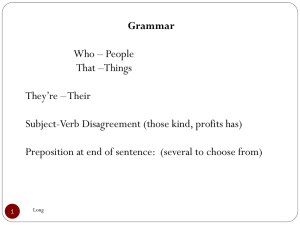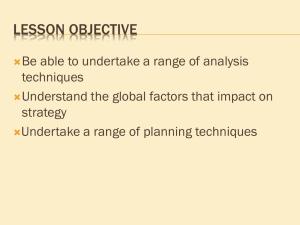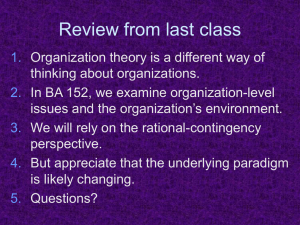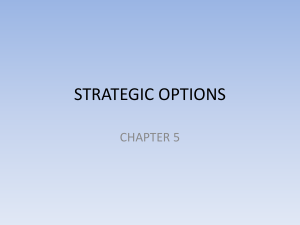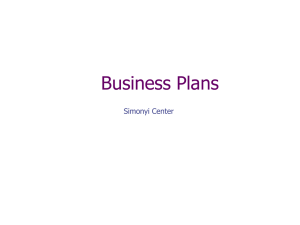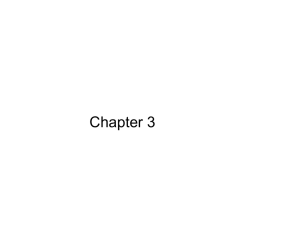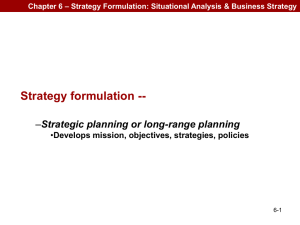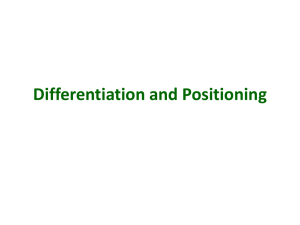Positioning Approach - Durham University Community
advertisement
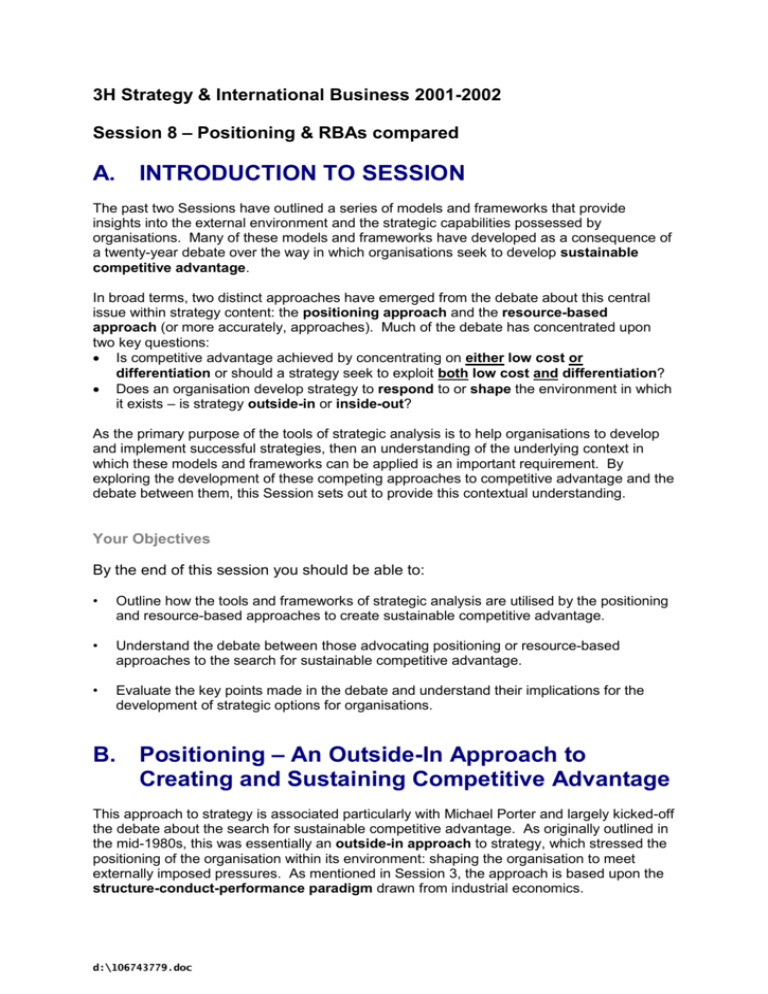
3H Strategy & International Business 2001-2002 Session 8 – Positioning & RBAs compared A. INTRODUCTION TO SESSION The past two Sessions have outlined a series of models and frameworks that provide insights into the external environment and the strategic capabilities possessed by organisations. Many of these models and frameworks have developed as a consequence of a twenty-year debate over the way in which organisations seek to develop sustainable competitive advantage. In broad terms, two distinct approaches have emerged from the debate about this central issue within strategy content: the positioning approach and the resource-based approach (or more accurately, approaches). Much of the debate has concentrated upon two key questions: Is competitive advantage achieved by concentrating on either low cost or differentiation or should a strategy seek to exploit both low cost and differentiation? Does an organisation develop strategy to respond to or shape the environment in which it exists – is strategy outside-in or inside-out? As the primary purpose of the tools of strategic analysis is to help organisations to develop and implement successful strategies, then an understanding of the underlying context in which these models and frameworks can be applied is an important requirement. By exploring the development of these competing approaches to competitive advantage and the debate between them, this Session sets out to provide this contextual understanding. Your Objectives By the end of this session you should be able to: • Outline how the tools and frameworks of strategic analysis are utilised by the positioning and resource-based approaches to create sustainable competitive advantage. • Understand the debate between those advocating positioning or resource-based approaches to the search for sustainable competitive advantage. • Evaluate the key points made in the debate and understand their implications for the development of strategic options for organisations. B. Positioning – An Outside-In Approach to Creating and Sustaining Competitive Advantage This approach to strategy is associated particularly with Michael Porter and largely kicked-off the debate about the search for sustainable competitive advantage. As originally outlined in the mid-1980s, this was essentially an outside-in approach to strategy, which stressed the positioning of the organisation within its environment: shaping the organisation to meet externally imposed pressures. As mentioned in Session 3, the approach is based upon the structure-conduct-performance paradigm drawn from industrial economics. d:\106743779.doc Structure Conduct Performance The underlying economic factors in an industry Strategies of competitors in an industry Profitability of competitors across industry as a whole Figure 5:1 – The Structure – Conduct – Performance Paradigm Porter argued that a company needed to understand the structure of its industry, so that it could change its strategy (its position within the industry) in order to achieve improved performance by outperforming its competitors. A successful strategy depended upon the company exploiting the underlying economic factors (such as economies of scale and scope) inherent within the industry better than its competitors and maintaining this over time so achieving sustainable competitive advantage. In essence, this is an outside-in approach to strategy, with the company choosing a strategy that meets the challenges posed by the external environment. Outlining the Positioning Approach Michael Porter outlined the main features of his approach in his text Competitive Advantage that was first printed in 1985. In this book he brought together a series of tools and models, some of which he had outlined in his earlier work. Although not described by Porter in precisely these terms, the analysis-choice-implementation framework (see Session 1) can be used to highlight how the tools and models come together within the positioning approach. Analysis Five Forces Framework Identify causes of competitive pressures within the industry Choice Implementation Strategic Group Analysis Identify the strategic characteristics of the industry and groups within it Generic Strategy Choose between: - Low Cost Leader - Differentiation - Focus Value Chain Configuration Structure value chain and value system to achieve chosen strategy Figure 5:2 – An Outline of the Positioning Approach d:\106743779.doc Value Chain Analysis Assess the capabilities of the organisation The positioning approach commences with an analysis of the external environment: the five forces framework being used to understand where the competitive pressures come from within the industry and strategic group analysis being used to better understand the main strategic characteristics within the industry and identify particular competitor groups. A value chain analysis can also help the organisation to understand its existing capabilities. In choosing a strategy the organisation needs to consider how it can position itself against the forces of competition within the industry: by using its capabilities to provide the best defence against these force(s); by influencing the balance of forces so that they favour the organisation’s strategy; or by anticipating shifts in forces and reacting to exploit them quicker than the competition. Porter argues that positioning determines whether a firm's profitability is above or below the industry average. A firm that establishes a favourable position can earn high rates of return even if general conditions within the industry are unfavourable and the average profitability of the industry is modest. Positioning depends upon exploiting the sources of competitive advantage that exist as a result of the underlying economic structure of the industry. As we saw in the last Session, competitive advantage can be divided into two types - low cost or differentiation. A further dimension to be considered is the scope of activities over which advantage is to be sought - many segments of the industry or just one or two. Porter argues that requires organisations to make a choice between the generic strategies outlined in the diagram below. Competitive Advantage Low Cost Differentiation Broad Low Cost Leader Differentiation Narrow Low cost focus Differentiation focus Competitive Scope Figure 5:3 – Generic Strategies (Adapted from M E Porter, Competitive Advantage, Free Press, 1985) Low Cost Leader According to this strategy the company seeks to be the lowest cost supplier serving most customer segments. It hopes to achieve superior profitability or competitive advantage through a lower cost base than its competitors, and consequently higher than average price/cost margin. The potential sources of this low cost position include economies of scale and scope and the experience curve. These sources of advantage need to be sustainable into the long term for the strategy to succeed. d:\106743779.doc Differentiation Here the company seeks to differentiate itself from its rivals by achieving a degree of uniqueness that is valued by many customer segments. The company can charge a price premium, where the premium achieved is more than the costs incurred, leading to higher than average margins. There are many potential ways of achieving differentiation, leading to perceived higher value for customers, including product features, branding and different delivery systems. Focus Here the company concentrates on one or two segments of the market using either cost focus or differentiation focus strategy. The sources of cost leadership and differentiation are similar to those discussed above. However, the success of a focus strategy depends upon a clear definition of the segment(s) served and the ability of the company to defend the segment from attack by broad scope competitors. Finally, the company needs to consider how to implement the chosen strategy. Porter argues that the activities that the organisation undertakes and the ways in which they are linked, as highlighted by the value chain and value system, can all contribute to the strategy if they exploit the sources of cost efficiency or value added available. LOW COST STRATEGY DIFFERENTIATION STRATEGY Critical Activities Efficient operations Low cost logistics & distribution Process Design - efficient processes Product Design - easy to make products HRM - good labour supervision Critical Activities Product design - innovative products Marketing - brand image promotion Service - quality customer service HRM - staff training Operations - quality assurance Cost Drivers Economies of scale Economies of scope Experience curve Supply costs Differentiation Drivers Service quality and levels Product features Delivery times Image Figure 5:4 – Generic Strategies and Value Chain Activities and Linkages By reconfiguring its value chain and wider value system, a company can concentrate upon the critical activities and linkages that exploit cost drivers or differentiation drivers based upon the sources of advantage. The critical point to recognise here is that there needs to be consistency between all these critical activities and linkages in order to deliver a clear generic strategy. Further, provided that these drivers can resist erosion by the actions of competitors then the chosen strategy is likely to deliver sustainable competitive advantage. d:\106743779.doc Whilst other tools like PEST analysis and market segmentation analysis have not been mentioned as part of the positioning approach, they can also be usefully employed in assessing the conditions of the external environment and potential customer requirements. Adaptations of the Generic Strategies Framework Michael Porter’s work in the mid-1980s led to a major debate about how organisations could create and sustain competitive advantage that has continued ever since. Some of the differing approaches that have emerged and the main points of contention within the debate will be explored in the following sections, including Porter’s response to his critics and his own later changes to the positioning approach. However, it is worth dealing with one aspect of the debate here. Many of the early criticisms of the generic strategies framework at the heart of the positioning approach questioned Porter’s clarity about the terms “low cost” and “differentiation”: did a low cost strategy mean selling at low prices and did a differentiation strategy require selling at a price premium? Later work that has offered some clarity on these questions, whilst still being consistent with the overall positioning approach, is the “Strategy Clock” developed by Cliff Bowman. In this adaptation of the generic strategies framework, Bowman argues that the key variables as far as positioning is concerned are those seen by the customer - price and perceived quality. Using these two dimensions a range of generic options (routes) can be identified for an organisation within an industry. Using the analogy of a clock there are broadly five potentially successful routes (combinations of price and perceived quality) and three routes ultimately likely to fail. These are illustrated in Figure 5.5. High Differentiation Hybrid 4 5 3 PERCEIVED ADDED VALUE Focused differentiation Low price 2 6 7 1 Low price/ low added value 8 Low Low PRICE Strategies destined for ultimate failure High Source: Based on the work of Cliff Bowman. See C.Bowman and D.Faulkner. Competitive and Corporate Strategy, Irwin, 1996. Figure 5:5 – The “Strategy Clock” d:\106743779.doc Each of the potentially successful routes draws on elements of low cost, differentiation and scope identified in the original generic strategies framework and are explored in a little more detail below: Low Price/Low Added Value (route 1) This strategy can work where there is a particular price-sensitive segment within a market. Customers within this segment recognise that the product/service provided is of low quality but the low price still makes it attractive or they are unable to buy higher priced products. Companies choosing this route need to strip out superfluous activities and linkages from their value chain in order that their cost base is as low as possible to support the low price offer. This focus strategy can only be sustained if the segment remains distinct from the rest of the market: customers are unwilling to buy higher price/quality alternatives and other competitors are unable to match the cost base of the company dedicated to this segment. Within the UK, supermarket chains like Aldi and Netto adopt this route by offering a limited range of “budget” brand groceries sold within unsophisticated stores with low levels of staff support, but very low prices. Low Price (route 2) Companies choosing a low price strategy aim to sell to a broad range of customers at lower prices than their competitors but offering a similar level of perceived quality of product/service. For such a strategy to be sustainable the company needs to be able to exploit sources of cost advantage like economies of scale or scope within its value chain. In terms of Porter’s original framework this is a low cost leader strategy, with cost advantages being invested in lower prices. The biggest risk with this route is that other competitors may seek to match price cuts, with a price war ensuing. Hence the strategy is sustainable only if the company can exploit and protect the sources of cost advantage in comparison to its competitors. The UK supermarket chain Asda, now owned by the American giant Walmart, uses the slogan “pocket the difference” to highlight lower prices across a broad range of groceries and other products like the “George” clothing brand. In common with many of its main competitors it also has in-store bakeries, fish counters and delicatessens within its stores. Hybrid (route 3) In outlining his original generic strategy framework, Michael Porter stressed the need to make a clear choice between low cost and differentiation strategies. However, some of his critics pointed out there seem to be many companies that are successful offering higher perceived quality at lower prices. Whilst the debate about low cost and/or differentiation will be explored further in the next section, the principles underlying this hybrid route are explored here. By selling in sufficient volume, companies are able to exploit the sources of cost advantage (economies of scale and scope, experience effects etc.). To achieve the required high sales levels, companies can attract customers through lower prices, higher perceived quality or some combination of both. Companies choosing this combined, or hybrid, route need to create a value chain and system that exploits cost advantages where possible, whilst balancing the needs to invest in the bases of differentiation to create perceived added value as well as lowering prices. Tesco, the UK’s largest supermarket chain, promotes itself under the “every little helps” slogan. The cost advantages Tesco possesses from being market leader allow them to offer broadly similar prices to Asda, but the company also aims to attract customers with a wider d:\106743779.doc range of grocery lines, prepared chilled foods, and non –food products, alongside in-store bakeries, delicatessens, dry cleaning and other services. Differentiation (route 4) The differentiation or higher perceived added-value route requires a company to structure their value chain and system so as to attract a broad range of customers on the basis of features they value other than lower prices. There are many possible means of differentiation (product range and quality, added features, reliability and high service levels are just some examples), they key being to identify those which are attractive to customers. It is important to realise that this route is aimed at many customer segments so prices may not be that different from competitors following routes 2 and 3, depending upon the market. Indeed, this option can be split further between those offering higher perceived value at no price premium, where cost advantages are still critical in underpinning the strategy, and those offering higher perceived value at a price premium. In either case, the sustainability of this strategy depends upon the company being seen to be offering something that is seen to be different to competitors, is valued by the customer and that this difficult for competitors to copy. After losing its position as the UK’s leading supermarket chain, Sainsbury’s performance has shown signs of recent improvement with a strategy based around “making life taste better”. An advertising campaign featuring the trendy TV chef Jamie Oliver promotes the quality and range of (sometimes exotic) foods available within Sainsbury’s stores. Interestingly, newspaper advertisements compare Sainsbury’s prices to Safeway, and vice-versa. Both store chains aim to follow a route of providing higher perceived quality, particularly in food ranges, rather than pursue the lower price routes adopted by Tesco and Asda. All that said, the intensity of competition between the largest supermarket chains and other smaller competitors has led to a series of short-term price wars, perhaps indicating a limit to sustainable price premiums for supermarkets following broad scope strategies. Differentiation Focus (route 5) In contrast to the broad scope strategies implied by routes 2, 3 and 4, a company pursuing a differentiation focus strategy aims to offer higher perceived value at a substantial price premium. As with a differentiation strategy there may be many ways of creating this higher perceived value, but the aim will be to make the product/service attractive to customers within a particular market segment who are not being well served by other competitive offerings. As with the low price/low quality strategy (route 1), the sustainability of this strategy depends upon the extent to which customers within the segment are unwilling or unable to buy from elsewhere. In the provision of high quality groceries at a high price premium to an exclusive segment of the market, then the Harrods’ Food Hall and Fortnum & Mason stores in London would be illustrations of companies following such an approach. Failure Strategies (routes 6 to 8) Only in rare circumstances (monopoly for instance) will companies following routes which involve raising prices without improving perceived quality, or reducing perceived quality whilst maintaining or raising prices, be likely to achieve positions of competitive advantage. Either the customer will go elsewhere or new companies following different approaches will enter the market. d:\106743779.doc Finally, it is worth highlighting the point that irrespective of whether the original generic strategy framework or the strategy clock is utilised, the positioning approach is not static. The relative positions of competitors will be constantly changing as their strategies change and new entrants come into the market place. Even if the company wants to maintain a particular strategy it will need to continually monitor how this will be seen within the market, making changes accordingly. SAA 1 The automobile industry has many competing companies, some of whom own more than one marque or brand. The main competitors include Ford, Nissan, Volkswagen, Renault, Toyota, Mercedes/Chrysler and General Motors. There is also a number of more specialist car makers like Jaguar, BMW, Ferrari, Bentley and Rolls-Royce, many of whom are now owned by the biggest players. In addition, recent years have seen the arrival of new entrants, particularly those located in the Asia-Pacific, like Proton and Kia. Using your knowledge of the companies listed and others of which you may be aware, attempt to classify the strategies adopted by the different marques using the strategy clock. Note that you may find that you cannot find examples of all the five possible successful routes to competitive advantage. d:\106743779.doc C. Resource-Based Approaches to Sustainable Competitive Advantage The emerging critique of positioning during the 1990s led to the development, by a number of different authors, of broadly similar views about the nature and creation of sustainable competitive advantage. Taken together these views form the basis of what has become known as the resource-based approaches that take a largely inside-out approach to the creation of sustainable competitive advantage. The views of some of the main proponents of these approaches are summarised below in Figure 5:6. Sustainable competitive advantage depends on: Hard to imitate organisational capabilities based on business processes which distinguish a company from its competitors in the eyes of the customers Stalk, Evans & Shulman, “Competing on Capabilities”, 1992 Core competences based on skills and technologies - the collective learning of the organisation Prahalad & Hamel, “The Core Competence of the Corporation”, 1990 Possession of capability differentials which are fed from a feedstock of intangible resources Hall, “A Framework for Identifying the Intangible Sources of Sustainable Competitive Advantage”, 1994 Distinctive capabilities which are a feature of its relationships, which others lack or cannot easily reproduce Kay, Foundations of Corporate Success, 1995 Figure 5:6 – Resource-based Approaches – Variations on a Theme Whilst each author tends to use slightly different language, there is a broad agreement on the way in which the resources and functional competences of the organisation are linked together by cross-functional strategic capabilities in ways which are difficult for competitors to copy, as discussed in Session 4. In these approaches the starting point is with the organisation rather than the challenges posed by the external environment. Never the less the strategy can only be seen to be successful if it is seen to be different to the competition and valued by customers. Also implicit in such an approach is that all sources of advantage are available to be utilised, provided that this is done in a unique way: there may be no need to choose between sources of low cost and differentiation. An Example of a Resource Based Approach Just as with the positioning approach, a range of tools and models can be used to assess and construct a suitable strategy. Many of the models, particularly the value chain, are d:\106743779.doc used by proponents of both camps – the differences often lie in the way in which the tools and for what purpose. Robert Grant has outlined one resource-based framework that can be used for strategy formulation, forming a useful link between the principles outlined above and tools/models with which we are now familiar. The outline of this approach is illustrated in Figure 5:7. Figure 5:7 – Grant’s Resource-based Framework Taking each of the stages in turn, the range of tools and models that can be utilised are explored below: Analyse the Firm’s Resources First, Grant suggests the need to identify, classify and assess the resources of the firm. The most important resources are likely to be intangible resources. As discussed in Session 4, Hall’s Intangible Assets and Resources framework could be useful here. Once identified, managers need to assess how their resource base compares with that of their competitors and identify opportunities to use these resources more efficiently. Analyse the Firm’s Capabilities The next stage is to analyse the way in which the resources of the organisation are combined with its competences to potentially create strategic capabilities. As we have seen previously, the most useful tool available to help in this process of identification and analysis is the value chain. Capabilities are created in the way in which the organisation uses its resources in the activities it undertakes and in the linkages between these activities and other value chains. d:\106743779.doc Grant again points out that the critical task for the manager is to assess these capabilities relative to those of its competitors. Such a requirement implies the need to conduct competitor analysis, perhaps by conducting similar analyses for major competitors and, as a minimum, being aware of the broad strategies they are following and the implications this has for the resources and capabilities of the company in question. As well as using value chain analysis, the other models for identifying core competences and strategic capabilities in Session 4 can also be applied. For example, activity mapping can help in seeing how activities are linked to creating capabilities, or one can follow the steps to identify core competences outlined by Gerry Johnson and Kevan Scholes, or apply Mahen Tampoe’s core competence analysis model. Appraise the Sources of Competitive Advantage The next stage of this resource-based approach is to “appraise the rent-generating potential of resources and capabilities” - based on economic rent as a measure of competitive advantage. This may sound quite intimidating but the concept is actually relatively simple to understand and is grounded in the underlying economics in a similar way to the positioning approach. If an organisation has sole access to a particular resource then it is able, in theory, to demand a higher price for its use by others, so increasing returns from its exploitation above that which would exist if it was freely available – these excess profits are the economic rent. The profits earned by a “pure monopoly” are a particular application of this definition. The ability of resources and capabilities to generate economic rents depend upon the opportunities they offer to exploit the sources of advantage, namely cost efficiency or added value (back once again to economies of scale and scope, the experience curve and the ability to differentiate oneself from the competition). Grant stresses the importance of considering the sustainability and appropriability of these sources of competitive advantage in assessing their long-term potential. He identifies four characteristics of the resources and capabilities of the organisation that are likely to be important determinants of sustainability: Durability – all resources and capabilities depreciate over time, so the rate of decline is important to the sustaining of competitive advantage. For example, technological change means that capital equipment and know-how can become obsolete. Similarly, brand names and reputation can also decline over time, as can the expertise of the company. Transparency - the ease with which competitors can identify, and subsequently duplicate or replace, a company’s sources of competitive advantage can be critical. Reverse engineering, where a competitor can dismantle products to see how they are designed and assembled, can reduce the length of time a company can maintain an advantage based on product technology. This has led to shorter product life cycles in many industries as companies try to outperform each other. Transferability - if a competitor can gain easy access to the resources and capabilities on which advantage is built, then sustainability is again reduced. The wholesale transfer of a dealing room team from one competitor to another is not uncommon in today’s financial markets. Similarly, if cost or added value advantage is based on process technologies that are available to all then it is likely to be short-lived. d:\106743779.doc Replicability - the more difficult it is to copy the resources and capabilities of a company, the more sustainable their advantage is likely to be. The sophistication of an organisation’s value chain and its ability to manage complex linkages all contribute to the sustainability. As we saw in the previous Session, this places particular stress on intangible assets and resources that are, by their nature, more difficult to identify and replicate. An organisation also needs to consider the appropriability of the returns from these sources of advantage - can others get the benefits of the resources and capabilities without owning or do they already belong to others? This is an important issue when considering strategic alliances with other organisations, as we shall see in the next Session. It is also an issue when an organisation’s advantage comes as the result of the skills of a limited number of employees. For example, changes to the contractual position of professional footballers playing in Europe as a result of free movement of labour principle, encapsulated in the “Bosman Ruling”, has led to increased players’ wages as clubs attempt to hold onto their stars or attract players from elsewhere. In effect, the returns for unique footballing capabilities now accrue largely to the star players rather than the clubs. Select a Suitable Strategy Grant argues that the essence of strategy formulation is to design a strategy that makes the best use of a firm’s most important resources and capabilities. Building upon the previous point, he identifies these key resources and capabilities as “those which are durable, difficult to identify and understand, imperfectly transferable, not easily replicated, and in which the firm possesses ownership and control”. For Grant, as with the other resource-based authors, this may well combine sources of cost efficiency and added value. In practice this means that many would dispute the underlying assumptions of Porter’s original generic strategy framework but that many could accept the options outlined within the strategy clock. The key is to recognise that whilst the resourcebased approaches stress the importance of looking internally at the resources and capabilities of the organisation, any successful strategy will still rest upon the strength of this mix of low cost and added value advantages relative to the external opportunities. Frequently, this is described in terms of the uniqueness that the strategy creates or is built upon. Jay Barney talks about the two assumptions of resource heterogeneity (different organisations having different resources) and resource immobility (the difficulty of transferring resources between organisations) that will underpin sustainable competitive advantage for those adopting resource-based approaches. Identify Resource Gaps and Develop Firm’s Resource Base The final stage of Grant’s framework is to identify ways in which the organisation can build on existing resources and capabilities in order to create future advantage. This means developing strategies that address resource gaps by enhancing current resources and capabilities, or acquiring new ones. For example, the car makers Honda and Rover created an alliance during the 1980s to mutually address the differing gaps in their resources and capabilities - Honda sought knowledge of European car styling, whilst Rover wanted access to expertise in manufacturing processes, particularly in quality management. As sustaining competitive advantage is critical, firms need to continually search for new ways in which to upgrade their resources and capabilities - finding new sources of cost efficiency or ways to add value. This can mean replacing existing sources of advantage even whilst the firm maintains an advantage over its competitors. For example, a consumer electronics company like Sony may launch a new product innovation, despite being the d:\106743779.doc market leader with the existing generation of products, in order to stay ahead of the competition. Illustration CREATING SUCCESS AT KWIK-FIT Sir Tom Farmer founded Kwik-Fit in197. But the 58-year-old self-made Scot, who yesterday announced that he planned to sell the business to US car giant Ford, reaping a personal windfall of £77m, insisted he would have no trouble working for somebody else. "I never felt I worked for myself anyway," said Sir Tom yesterday from his group's Edinburgh headquarters. "I always thought I worked for a company called Kwik-Fit which has 8,000 shareholders and 9m customers." Sir Tom left school at 14 to join a tyre firm as a stores boy before setting up his first venture a tyre and accessory company - 10 years later. Fours years after that he sold up and retired to California for a year before getting bored and returning home to found Kwik-Fit in 1971. The idea was simple. Drivers were offered an instant fix for their exhausts, tyres or brakes backed up with a zealous commitment to service, a trait for which the independent garage industry was not renowned. The business was a success and Sir Tom built up a strong brand. Kwik-Fit and its catchy advertising jingle sung by dancing fitters, “You can’t get better than a Kwik-Fit fitter, We’re the ones to trust”, are now so much part of the UK scene that it is easy to forget how much the group has changed the industry it operates in. Driving into a Kwik-Fit garage, the motorist can have new tyres, brakes or an exhaust fitted to their car whilst sitting in a clean waiting room with views of the working area. The specialisation on only a limited range of garage services means that the facilities and fitters are tailored to the specific operations required. The large turnover of cars also means that the motorist is offered a good range of the main branded and own-label products at very competitive prices. Punctures and broken exhausts are “part of the joys of motoring”, often taking place at inconvenient times and away from home. Kwik-Fit has a national coverage of branches and is open seven days a week. A credit card scheme also allows the motorist to cope with the unexpected repair and spread payments. In recent years, some of the main car manufacturers, including Ford, have attempted to set up similar operations within their main dealership networks. However, success has been limited, with many motorists still believing that such garages will charge the traditionally high dealership prices. The dealerships also have the problem of separating this quick turnover service from their more complex full maintenance operations. Add Kwik-Fit’s move into selling insurance in 1995 and last year's expansion into continental Europe with the £105m acquisition of a French business, and the attractions the group holds for Ford become clear. Ford first approached Kwik-Fit at the end of last year, at which point the two groups first discussed possible joint ventures. But the agenda quickly moved on to a take-over. Sir Tom had rejected offers in the past - notably and most publicly an approach in 1989 from d:\106743779.doc Continental, the German tyre group. This time, he said, the time was right, but "we mainly did it because Ford is right". "This is a terrific development," he said. "Businesses and industries keep changing and the automotive industry itself is changing. To be approached by a company of such standing and prestige as Ford means this gives us a tremendous future." Last month, announcing a 17 per cent increase in pre-tax profits to £64.3m, Sir Tom signalled a year of consolidation, promising to pay off the group's £105m of debt - taken on to fund the European acquisition - "as soon as possible". Now, with the financial muscle that being part of Ford will bring, Kwik-Fit can step up its growth. The group needs to expand its continental European operations - predominantly those in Germany, where it trades under the Pitstop name and in France, Belgium and Spain where it trades as Speedy. Sir Tom said the number of German outlets could easily be increased from 160 to as many as 450, while the small presence in Spain and Portugal could grow to about 250. He said that the group's longer-term focus would be on services for cars from the showroom to the scrap yard. Almost any car-related business would be considered, with the most likely being bodyshops, car accessory retailing, and windscreen and radio replacement. Sir Tom said that in striking the deal he "felt like the father of the bride who is there giving his daughter away". However, he stressed that he had done that in real life and gained "three beautiful grandchildren". He said he held out the same hopes for the marriage with Ford. Source: based on an article by Susanna Voyle in the Financial Times, Tuesday April 13, 1999. d:\106743779.doc SAA 2 Read the illustration Creating Success at Kwik-Fit and identify the sources of competitive advantage within the company at the time of its take-over by Ford. Assess the sources of competitive advantage you have identified for sustainability and appropriability. Sustainability: Durability Transparency Transferability Replicability Appropriability Given the future strategy for the organisation outlined by Sir Tom Farmer at the end of the illustration, what comments would you make concerning potential resource gaps and development of the resource base? d:\106743779.doc D. The Debate between the Positioning Approach and Resource-based Approaches To a large extent, the debate about the approach to creating sustainable competitive advantage began with Michael Porter in the early 1980s. Many of the resource-based approaches grew out of a critique of the positioning approach during the 1990s. However, Michael Porter did not take the critique of positioning lying down and he is still playing a key role in the debate about sustainable competitive advantage. This section explores the two questions that have remained at the heart of this debate for over twenty years: Are low cost and differentiation mutually exclusive? Should the search for sustainable competitive advantage be outside-in or inside-out? Are Low Cost and Differentiation Mutually Exclusive? In his original work, Michael Porter argued that as the ways in which organisations sought to exploit sources of low cost or differentiation depended upon largely different and contradictory activities, those organisations that failed to make a clear choice between generic strategies were likely to become “stuck in the middle”. However, many resource-based proponents, including Richard Grant, have argued that as the activities that exploit low cost or differentiation advantages are different then they will not necessarily conflict. Indeed, an organisation should seek to exploit all sources of advantage open to it in order to create a unique strategy. Indeed, in an article published in 1996 called “What is Strategy?” Michael Porter argued that a company creates sustainable competitive advantage by delivering greater value, creating comparable value at lower cost, or by doing both. The stress was on the unique mix of value created by a different set of activities rather than the choice between low cost and differentiation. In other words, he had changed his own position! That said, in the same article, Porter raised a number of issues directed at some of the proponents of resource-based approaches. These issues are explored below: Operational Effectiveness and Strategy Porter made a distinction between operational effectiveness and strategy. Operational effectiveness meant performing similar activities better than rival competitors, whilst strategy was about performing different activities to rivals or performing similar activities in different ways. He argued that operational effectiveness meant organisations doing things better, whether that was improving value to the customer or improving the company’s relative costs. It was about better utilisation of resources reducing defects or developing new products faster. This is consistent with the view that sees no conflict between pursuing cost efficiency and added value. However, Porter went on to argue that operational effectiveness is a necessary but not sufficient condition for superior performance. He highlighted this by reference to what he calls the productivity frontier shown in Figure 5:8. d:\106743779.doc Figure 5:8 – The Productivity Frontier The productivity frontier shows the state of best practice at any moment in time achievable in terms of value added and cost efficiency. Not all organisations have achieved best practice so, like Company A, they can increase operational effectiveness by adopting techniques like TQM and benchmarking, improving both cost efficiency and value added. However, once the productivity frontier is reached, as with Company B, there is a need to make a choice between further cost efficiencies or adding value, as both cannot be improved simultaneously. In other words, the company needs to define a unique strategy with a different mix of low cost and added value to competitors. Dangers of Hypercompetition For Porter, the risk of most competitors in an industry pursuing similar routes to operational effectiveness is that the competitors merely shift the productivity frontier outwards over time. Whilst absolute operational effectiveness increases, there is no relative improvement for any one competitor. In such circumstances competitors come increasingly to resemble each other as they seek the same improvements through benchmarking against each other. The result, argued Porter, was hypercompetition with companies facing diminishing returns as they become increasingly homogenous - with similar cost structures, new product development times, product quality etc. Perhaps the recent history of restructuring in the car industry, with many mergers and alliances across the globe reflects the pressures of hypercompetition? Is the Search for Competitive Advantage Outside-in or Insideout? The previous sections in this Session have highlighted the way in which the positioning approach can be seen as outside-in, whilst the resource-based approaches are inside-out. What is meant by these descriptions and can the implied differences be resolved? A number of points can be made in this debate to both more closely define the meaning of the terms and to explore remaining points of agreement or difference: d:\106743779.doc Strategy Content or Strategy Process? In discussing the nature of strategy in Session 1, a distinction was drawn between strategy content and strategy process. At first sight, the frameworks for positioning and resourcebased approaches outlined above seem to suggest particular views about the process of strategy formulation – each describing a series of stages that need to be undertaken in order to devise a new strategy. In fact, as the example of Churchill Tableware illustrated, the process tends to be less rationalistic and sequential in practice – most companies will not slavishly follow the stages of either the positioning approach or a resource-based approach. However, this insight into strategy as it is practiced does not invalidate the central issues that are at the heart of this debate. Both the positioning approach and the resource-based approaches are largely concerned about the relative significance of the external environment and organisational capabilities upon the underlying logic of particular strategies. In other words, the debate about positioning or resource-based approaches is largely about strategy content – should a company’s strategy be market-driven or capabilities-driven? One Size Fits All? A colleague at Durham University commented on the range of companies frequently highlighted by proponents of a resource-based approach, stating that “not one of them clothes you, feeds you or puts a roof over your head”. He graphically illustrated a point that certain strategies may suit companies in certain industries - computer software, financial services and consumer electronics for example - but that it is dangerous to assume that similar strategies will suit all contexts. Interestingly, this mirrors one of the original critiques of the generic strategies framework: imposing a limited range of options irrespective of the external context. It is usually dangerous to assume there is only one right answer to the problem. Whatever approach is taken, a strategy needs to build upon the capabilities of the particular organisation whilst addressing the challenges of the particular external environment in which it exists. Re-defining Positioning As mentioned above, Michael Porter has changed approach to positioning. From a supply side perspective he now argues, in line with a resource-based approach, that positioning depends upon a unique set of activities based on cost, value or both. However, he also stresses the importance of a demand side perspective – defining a position within the market that is distinct from competitors, serving customers in a different way or serving different customers. He goes on to define three approaches to positioning that can individually or jointly define the company’s approach to the market: Needs-based positioning - serving the needs of a particular group of customers with a tailored set of activities e.g. IKEA, the Swedish furniture retailer, targets designconscious but price-sensitive furniture. These customers are willing to trade time erecting the ready-to-assembly products in return for a low price. The company operates out of large self-service stores with its products displayed in room-like settings to allow customers to see how the items will fit into their own homes. The chosen items are then selected from pallets in the warehouse section of the store. Variety-based positioning - producing a sub-set of an industry’s products, which attract customers some of the time e.g. Kwik-Fit (see the illustration above) concentrates on d:\106743779.doc replacing tyres, exhausts and brakes on a while-you-wait basis rather than offering a full range of car maintenance services. Access-based positioning - using a different set of activities to reach customers in a new way, often as a function of geography or scale e.g. Carmike operate very low cost cinemas across the rural USA, enabling it to operate in towns with smaller populations than other multiplex chains. Carmike builds standardised theatre complexes with fewer screens and less sophisticated projection technology. Proprietary information systems and management processes reduce overheads and staff costs, whilst group purchasing power ensures the pick of films on good terms from the distributors. The critical point here is to see that a successful strategy needs to be unique and seek to reach target customers in ways that are difficult for competitors to copy or circumvent. Dealing with Uncertain Futures One of the key insights of the resource-based approaches was to see that one of the primary roles of strategy was to invest in the resources and capabilities of the organisation, both to build on the existing resource base and to cover resource gaps. This is particularly important if the future is uncertain. In their article, Competing on Capabilities, George Stalk, Philip Evans and Lawrence Shulman argue that dominating an existing market segment might be less important than being able to create new products and exploit them quickly. Their stress is upon the organisation’s capabilities to meet or even anticipate market trends and customer needs, trying out new ideas and moving quickly into new market opportunities. This means that the organisation needs to focus upon the development of those capabilities that may allow it to compete successfully in the future. E. Summary This Session has focused upon two approaches to the search for sustainable competitive advantage, outlining the elements in each approach and the tools and models that can be used at each stage. The positioning approach stresses the need for an organisation to make a clear choice about its strategy, based on sources of low cost and differentiation advantage, so that it addresses the challenges it faces from the external environment. The resource-based approaches stress the need to build and use the resources and capabilities of the organisation so that it can exploit sources of low cost and differentiation advantage in a unique manner. Over the past twenty years a debate has raged over which of these approaches best meets the needs of organisations as they seek to develop successful strategies. The two central questions in this debate have been: Are low cost and differentiation mutually exclusive? Whilst the early debate concentrated upon whether these sources of advantage could be combined, the stress today is upon achieving a unique combination of low cost and differentiation advantage that makes the organisation distinct from its competitors either in what it does or how it does it. Is the search for competitive advantage outside-in or inside-out? The positioning approach is often described as outside-in, whilst the resource-based approaches are seen as inside-out. However, this is less about describing the stages of d:\106743779.doc a strategy process and more about the underlying logic of the strategy content – should the strategy be market-driven or capabilities-driven. Most within the argument now accept that both are important – distinct positioning within the market compared to competitors and the development of capabilities to meet ever-changing market needs are both pre-requisites for sustainable competitive advantage. d:\106743779.doc

